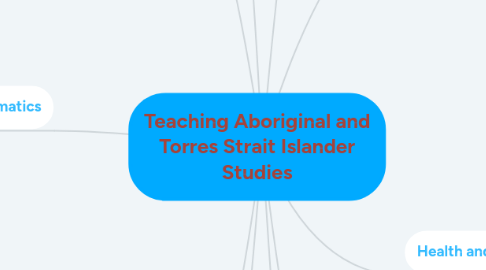Teaching Aboriginal and Torres Strait Islander Studies
by Alana Cipriani

1. Humanities and Social Science
1.1. Key Word- Stolen Generation
1.2. Assessment- Rabbit Proof Fence
1.3. Year Level- 5
1.4. Learning objectives- • views the movie and explores the impact of removing children from their families, on Aboriginal people; •explores the rationale behind Government policy of removing children, and attitudes of the non-Aboriginal population towards the policy;
1.5. Learning outcomes- Roles, responsibilities and participation The key values that underpin Australia's democracy, including freedom, equality, fairness and justice (ACHASSK115)
1.6. Cross- Curriculum priority- English, Humanities and Social Science
1.7. Resources – The movie- Rabbit Proof Fence
2. Science
2.1. Key Word- Culturally appropriate
2.2. Assessment - Caring for wetlands
2.3. Year Level- 5
2.4. Learning objectives- • moves towards understanding Aboriginal people and in particular local people, the Noongars; • moves towards respecting particular aspects of Aboriginal culture, namely how the people took care of wetlands and lived in harmony with their environment; • moves towards understanding that caring for wetlands is important to sustainability of the environment;
2.5. Learning outcomes- BIOLOGICAL SCIENCES Living things have structural features and adaptations that help them to survive in their environment (ACSSU043)
2.6. Cross- Curriculum priority- Art, English, Sustainability, Society and Environment
2.7. Resources – Internet- hand out sheets which explain aboriginal words for wetlands, worksheet to point out which objects do not belong in the wetlands.
3. Mathematics
3.1. Key word- Culturally Responsible
3.2. Assessment- Goanna Jumps High
3.3. Year level- 5
3.4. Learning objectives- infer the meaning of figurative language, identifying similes in the story; • experience alternate types of questioning that shows understanding of the text; • use measurement skills to estimate height. • Discuss how high the goanna jumped at different times and what unit of measurement they could use to measure these jumps.
3.5. Learning outcomes- Use estimation and rounding to check the reasonableness of answers to calculations (ACMNA099)
3.6. Cross- Curriculum priority- English, Humanities and social science
3.7. Resources – Book Goanna jumps high, tape measurements, metre rules, student’s personal rulers
4. Technology
4.1. Key Word- Reconciliation
4.2. Assessment- National Reconciliation Week
4.3. Year Level - 5
4.4. Learning objectives- Students understand the significance of Reconciliation week and are able to research the importance of Reconciliation towards Aboriginal people.
4.5. Learning outcomes- Collaborating and managing Work independently, or collaboratively when required, to plan, safely develop and communicate ideas and information for solutions (WATPPS32)
4.6. Cross- Curriculum priority- Humanities and social science
4.7. Resources – Laptops
5. 1.4 Strategies for teaching Aboriginal and Torres Strait Islander students Demonstrate broad knowledge and understanding of the impact of culture, cultural identity and linguistic background on the education of students from Aboriginal and Torres Strait Islander backgrounds.
6. English
6.1. Key word- Culture
6.2. Assessment- Aboriginal family life
6.3. Year level - 5
6.4. Learning objectives 1. listen to and retells stories from the Dreaming; 2.researches the significance of Dreaming stories to the family; 3.Compares roles of traditional Aboriginal family members with those in their own families;
6.5. Learning Outcomes Interacting with others- Clarify understanding of content as it unfolds in formal and informal situations, connecting ideas to students’ own experiences and present and justify a point of view (ACELY1699)
6.6. Cross- Curriculum priority- Technology
6.7. Resources- laptops, Aboriginal elders guest speakers
7. Art and Music
7.1. Key Word- Dream Time
7.2. Assessment- Dot Painting
7.3. Year level- 5
7.4. Learning objectives • recognises the importance of contributions made by Aboriginal artists; • considers popular traditional and contemporary arts, including those from other times and places; • understands how Aboriginal
7.5. Learning outcomes – Responses that identify and describe, using visual art terminology, how visual art elements and techniques are used to communicate meaning and purpose in artwork (ACAVAR117)
7.6. Cross- Curriculum priority- English, Technology, Languages, Humanities and Social Science
7.7. Resources- Collection of dot painting pictures, art materials, projector and screen for viewing, Australian aboriginal arts website.
8. Health and Physical Education
8.1. Key word- Sense of belonging
8.2. Assessment- Food Groups
8.3. Year Group 5
8.4. Learning objectives- • identify the five food groups, • identify foods which are essential for health, • identify benefits of fruits and vegetables, • identify bush foods, • self-monitor daily food intake, and • make decisions for a healthier diet or maintaining a healthy diet.
8.5. Learning outcomes- Ways that individuals and groups adapt to different contexts and situations (ACPPS051)
8.6. Cross- Curriculum priority- Humanities and social science
8.7. Resources – writing material
9. Language
9.1. Key word- Traditional Language
9.2. Assessment- Noongar Language
9.3. Year level- 5
9.4. Learning objectives • recognises there are different Noongar language groups in the South West of Western Australia; • identifies towns’ names in their region; finds and records Aboriginal names for the towns, and their meanings;
9.5. Learning outcomes- Interact with peers, the teaching team and visiting Elders/community speakers about aspects of their personal worlds, such as experiences at school, home, everyday routines and favourite pastimes, interests and activities (ACLFWC088)
9.6. Cross- Curriculum priority- English, Humanities and social Science
9.7. Resources- Laptops, atlases, community guest speakers
10. 2.4 Understand and respect Aboriginal and Torres Strait Islander people to promote reconciliation between Indigenous and non-Indigenous Australians Demonstrate broad knowledge of, understanding of and respect for Aboriginal and Torres Strait Islander histories, cultures and languages.


